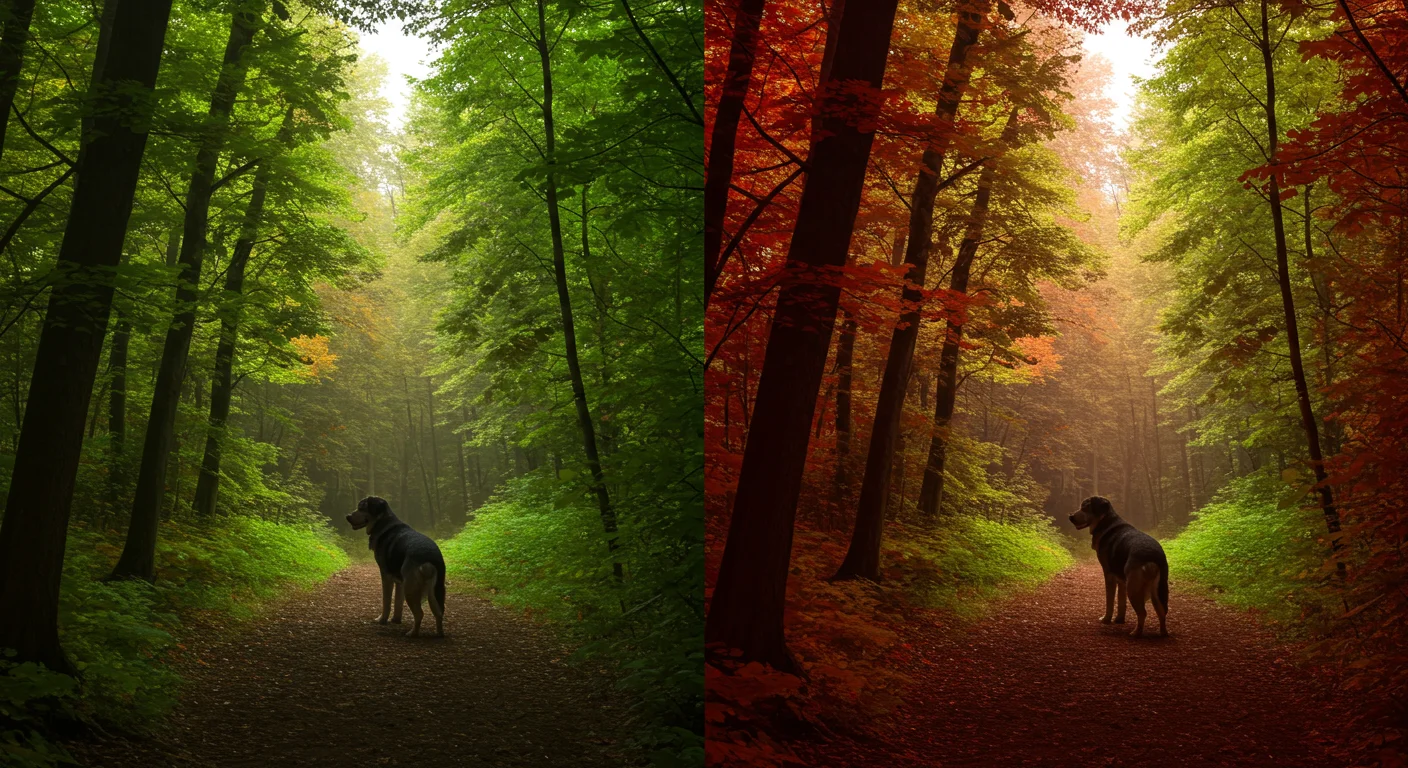Beyond Our Spectrum: Understanding the Colors Animals See (And Why There’s No ‘Best’ Color)
Have you ever wondered if your dog sees the world in the same vibrant colors that you do? Or perhaps how a bee finds its way to the nectar-rich centers of flowers? The world of animal vision is far more complex and diverse than we often realize. The truth is, animals perceive color in vastly different ways, and there isn’t a single “best” color for them all. In this post, we’ll dive into the fascinating science of animal vision and explore how different species see color, and why it’s so specific to their needs.
The Science of Animal Vision: It’s Not Just About What You See, But How You See
Unlike humans, who generally see the world with trichromatic vision (meaning we have three types of cone cells that enable us to see a wide range of colors), many animals have dichromatic (two cone cell types) or even monochromatic vision (one cone cell type). The presence of these cone cells determines how an animal perceives color, and this affects how they interact with their surroundings.
-
Photoreceptors: Rods and Cones: Animal eyes have two main types of photoreceptors:
-
Rods: These are highly sensitive to light and are important for night vision and detecting movement. Rods do not perceive colors.
-
Cones: These are responsible for color vision. The number and type of cones an animal possesses determine the colors they can perceive.
-
-
Color Vision Explained:
-
Trichromatic Vision: Humans, along with some primates and other species, have three types of cone cells that are sensitive to red, green, and blue light. This allows us to perceive a wide spectrum of colors.
-
Dichromatic Vision: Many mammals, like dogs and cats, are dichromatic, meaning they have two types of cone cells. Typically, these respond to blue and yellow light, making it difficult to distinguish between red and green hues.
-
Tetrachromatic Vision: Many birds, reptiles, and some fish have four types of cone cells. This gives them a broader range of vision, including the ability to see ultraviolet (UV) light, which humans cannot see.
-
Monochromatic Vision: Animals with only one type of cone cell or none, primarily perceive the world in shades of gray.
-
-
Beyond the Spectrum: It’s important to remember that color perception also includes how the brain processes these visual signals. Animals don’t just see light; they interpret information differently, which changes their view of color in ways we can’t fully imagine.
Why There’s No Single “Best” Color for All Animals: It’s All About Context
The idea of a “best” color is entirely relative and depends on the animal and its environment. Let’s look at some specific examples:
-
Predators: Predators often have enhanced movement detection and contrast sensitivity. For example, a hawk sees a wider range of colours and UV light, allowing it to differentiate between a camouflaged mouse from the grass from the sky.
-
Prey: Prey animals, on the other hand, often use color for camouflage and predator detection. They need to be able to blend seamlessly into their surroundings and also pick up on changes in color that might signal a threat.
-
Nocturnal Animals: Nocturnal animals, like owls and bats, have vision that is primarily geared towards detecting light in low-light conditions. They often rely on shades of gray more than specific colors. They may even be able to see in the infrared spectrum.
Let’s look at how color vision differs across several species:
-
Dogs and Cats: A Blue and Yellow World: Dogs and cats have dichromatic vision, meaning they lack the red-green cone cells that humans possess. This doesn’t mean they can’t see color; they simply see a narrower range, mostly in shades of blue and yellow. Red and green hues will appear as shades of gray to them.
-
Birds: Masters of the Full Spectrum: Many birds are tetrachromatic, giving them a much broader color spectrum than humans. This includes the ability to see ultraviolet (UV) light. This allows birds to detect UV patterns on feathers, food, and flowers that are invisible to us, giving them an advantage for foraging and mating.
-
Bees: UV Navigators: Bees rely heavily on UV light for navigation and foraging. They see unique ultraviolet patterns on flowers, which help guide them to nectar and pollen sources. What appears as one color to us may have intricate patterns visible to bees.
-
Reptiles: Ultraviolet Communication: Some reptiles, like certain lizards, use ultraviolet light for both mating and prey detection. They see patterns and colors invisible to humans, which play an important role in their social interactions.
-
Fish: Adapting to Depth: Fish color vision varies greatly based on their habitat. Fish in shallow water might be able to see many colors, while those in deep water often have monochromatic vision and are more sensitive to light intensity.
Color and Animal Behavior: More Than Just Pretty
Animals use color in fascinating ways:
-
Camouflage: Many animals use color to blend into their environments. For example, the chameleon is a master of camouflage, changing its color and pattern to match its surroundings, hiding from both predators and prey.
-
Mating: Color plays a critical role in attracting mates. Male peacocks are known for their elaborate, colorful tail feathers, which they display to females during courtship rituals. These vivid colors are specifically designed to capture a female’s attention.
-
Communication: Color is used as a form of visual signaling. Bright, vibrant colors can communicate a variety of messages, ranging from aggressive dominance displays to mating signals.
-
Warning Signals (Aposematism): Bright colors often signal danger. For example, poison dart frogs use their vibrant colors as a warning to predators that they are poisonous. These colors help protect them from predators who learn to associate the bright coloration with danger.
The Impact of Our Perceptions on Animals: Responsibility and Understanding
As humans, understanding animal vision is essential to responsible interaction:
-
Enclosure Design: When designing enclosures or habitats for animals, you have to consider the colors that are most visible and comfortable for the animals. For instance, if a cat’s enclosure has too many red objects, they may not be able to see them very well, which may cause discomfort and confusion.
-
Toy and Environment Design: When designing toys, it is important to consider what colors the animals can perceive. For example, many dog toys are designed in shades of blue or yellow because these are the colors that are most visible to them.
-
Interactions: When interacting with animals, your clothing colors or equipment can affect how they perceive you. For example, a bird might be startled if you wear a bright yellow jacket, and a cat might not be as interested in a red object as you thought it would be.
-
Research: Continue to learn about the various ways different animals experience color to better understand their needs and behaviors.
The Role of Environment: It’s All Connected
An animal’s environment plays a big role in how it uses color:
-
Light Levels: Animals living in low light environments might have vision that is optimized for detecting light and movement but be less sensitive to colors. This is why nocturnal animals have very different eyes than their daylight-active counterparts.
-
Habitat: An animal’s surroundings greatly impact their need for color perception. For example, animals in densely forested habitats might have vision that enhances the ability to see through shadows and see the difference between various shades of green.
-
Diet: Diet can influence the development of the visual system. For example, birds that eat fruit often have superior color vision, as they must be able to distinguish ripe, nutritious fruit from unripe and inedible.
Conclusion: Appreciating the Diversity of Animal Vision
In the realm of animal vision, there’s no single “best” color. The best colors for animals are those that best serve their needs for survival, communication, and interaction with their environment. It’s not about what we see, but about understanding how they experience their world through their unique visual abilities. By appreciating this diversity, we can gain a richer understanding of the natural world and our place within it.
Call to Action
Have you learned something new about animal vision? Do you have any interesting facts about how animals use color? Share your thoughts, questions, or observations in the comments below! Don’t forget to share this post with others who might be interested in the fascinating world of animal behavior and biology.
Read More :
Best Soil for Winter Plants in Georgia
latest video
news via inbox
Nulla turp dis cursus. Integer liberos euismod pretium faucibua




